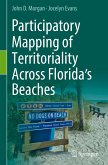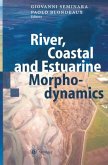K. F. Nordstrom
Estuarine Beaches
An introduction to the physical and human factors affecting use and management of beaches in estuaries, lagoons, bays and fjords
K. F. Nordstrom
Estuarine Beaches
An introduction to the physical and human factors affecting use and management of beaches in estuaries, lagoons, bays and fjords
- Gebundenes Buch
- Merkliste
- Auf die Merkliste
- Bewerten Bewerten
- Teilen
- Produkt teilen
- Produkterinnerung
- Produkterinnerung
The purpose of this book is to supply the background needed to structure research on estuarine beach resources and provide the basis for a program for informed management. The book is a synthesis of data on physical, biological, and human processes.
Andere Kunden interessierten sich auch für
![Chicago Beaches Chicago Beaches]() Chicago Beaches27,99 €
Chicago Beaches27,99 €![Estuarine Dynamics in Flux: Time to Deepen Our Understanding Estuarine Dynamics in Flux: Time to Deepen Our Understanding]() SHIVAEstuarine Dynamics in Flux: Time to Deepen Our Understanding27,10 €
SHIVAEstuarine Dynamics in Flux: Time to Deepen Our Understanding27,10 €![Beaches of Hong Kong Beaches of Hong Kong]() Beaches of Hong Kong23,99 €
Beaches of Hong Kong23,99 €![Participatory Mapping of Territoriality Across Florida's Beaches Participatory Mapping of Territoriality Across Florida's Beaches]() John D. MorganParticipatory Mapping of Territoriality Across Florida's Beaches106,99 €
John D. MorganParticipatory Mapping of Territoriality Across Florida's Beaches106,99 €![River, Coastal and Estuarine Morphodynamics River, Coastal and Estuarine Morphodynamics]() River, Coastal and Estuarine Morphodynamics193,99 €
River, Coastal and Estuarine Morphodynamics193,99 €![Estuarine Cohesive Sediment Dynamics Estuarine Cohesive Sediment Dynamics]() Estuarine Cohesive Sediment Dynamics81,99 €
Estuarine Cohesive Sediment Dynamics81,99 €![The Beaches The Beaches]() The Beaches31,99 €
The Beaches31,99 €-
-
-
The purpose of this book is to supply the background needed to structure research on estuarine beach resources and provide the basis for a program for informed management. The book is a synthesis of data on physical, biological, and human processes.
Hinweis: Dieser Artikel kann nur an eine deutsche Lieferadresse ausgeliefert werden.
Hinweis: Dieser Artikel kann nur an eine deutsche Lieferadresse ausgeliefert werden.
Produktdetails
- Produktdetails
- Verlag: Springer / Springer Netherlands
- Artikelnr. des Verlages: 978-1-85166-728-4
- 1992.
- Seitenzahl: 252
- Erscheinungstermin: 31. Mai 1992
- Englisch
- Abmessung: 235mm x 157mm x 19mm
- Gewicht: 540g
- ISBN-13: 9781851667284
- ISBN-10: 1851667288
- Artikelnr.: 23088750
- Herstellerkennzeichnung Die Herstellerinformationen sind derzeit nicht verfügbar.
- Verlag: Springer / Springer Netherlands
- Artikelnr. des Verlages: 978-1-85166-728-4
- 1992.
- Seitenzahl: 252
- Erscheinungstermin: 31. Mai 1992
- Englisch
- Abmessung: 235mm x 157mm x 19mm
- Gewicht: 540g
- ISBN-13: 9781851667284
- ISBN-10: 1851667288
- Artikelnr.: 23088750
- Herstellerkennzeichnung Die Herstellerinformationen sind derzeit nicht verfügbar.
Definitions and locations of estuarine beaches. Definitions. Location of
estuarine beaches. Beaches in urbanized estuaries. Keil Fjord. San
Francisco. San Pablo Bays. Raritan and Delaware Bays, New Jersey. Summary.
Waves, currents, and water level changes. Characteristics of estuarine
waves. Wave heights. Influence of water level. Characteristics of water
elevation spectra. Wave generation and prediction. Wave refraction. Ocean
wave inputs. Relative sea level changes. Longshore currents. Storm surges.
Ship and boat wakes. Ice. Summary. Beach and shoreline characteristics.
Beach sediments. Sandy beaches. Gravel beaches. Depth of the active beach.
Resistant formations in the beach matrix. Biologic effects. Vegetation.
Fauna. Beach widths. Shoreline orientation. Longshore transport rates.
Rates of shoreline change. Dunes. Human processes and shoreline
alterations. Summary. Changes in beach morphology and sediment volumes. The
high-energy ocean-beach model. Models for meso-tidal estuarine beaches.
Response to high-energy waves on estuarine beaches. Response to differences
in longshore sediment transport. Likelihood of morphologic responses.
Beaches in developed areas. Long-term changes in morphology and sediment
volume. Micro-tidal estuarine beaches. Macro-tidal estuarine beaches.
Gravel beaches. Bars. Multiple shore-parallel bars. Transverse bars.
Summary. Resource values of estuarine beaches. Ecological values. Human
resource value. Protective values. Boat launch. Investment potential.
Recreation. Physical advantages of estuarine beaches. Alterations to
enhance recreation. Importance of access. Factors discouraging recreational
use. Priorities for use of recreation beaches. Summary. Shore protection
alternatives. The no-action alternative. Land use control. Static
protection structures. Construction materials. Breakwaters. Perched beach.
Groins. Bulkheads, revetments and seawalls. Vegetation. Dunes beach
nourishment. Summary. Management considerations. Major federal programmes.
The Coastal Zone Management Act. The Coastal Barrier Resources Act. The
National Flood Insurance Program. Corps of engineer activities. Other
federal programmes. State management programmes. Waterfront development
laws. Wetlands and tidelands management acts. Water quality planning and
maintenance programmes. Erosion control setback lines. Site plan reviews
for large-scale developments. Park and recreation programmes. Local
governments. Regional authorities and commissions. Implications of managing
estuarine beaches. Criteria for erosion control. Decisions affecting use
and development of estuarine beaches. Determining locations of beaches.
Evaluating beach processes. Determining beach characteristics. Determining
the origin of beaches. Assessing the likelihood of survival of beaches.
Uses or values of existing beaches. Factors that can enhance the value of
estuarine beach resources. Creation of new public estuarine beaches.
Controls to ensure maintenance and value of public beaches. Conflicts
between recreational uses and ecological values. Summary. Research needs.
Process studies. Sediment movement and beach change. Alternatives for shore
protection. Resource values. Human values. Ecological values. Conclusions.
References.
estuarine beaches. Beaches in urbanized estuaries. Keil Fjord. San
Francisco. San Pablo Bays. Raritan and Delaware Bays, New Jersey. Summary.
Waves, currents, and water level changes. Characteristics of estuarine
waves. Wave heights. Influence of water level. Characteristics of water
elevation spectra. Wave generation and prediction. Wave refraction. Ocean
wave inputs. Relative sea level changes. Longshore currents. Storm surges.
Ship and boat wakes. Ice. Summary. Beach and shoreline characteristics.
Beach sediments. Sandy beaches. Gravel beaches. Depth of the active beach.
Resistant formations in the beach matrix. Biologic effects. Vegetation.
Fauna. Beach widths. Shoreline orientation. Longshore transport rates.
Rates of shoreline change. Dunes. Human processes and shoreline
alterations. Summary. Changes in beach morphology and sediment volumes. The
high-energy ocean-beach model. Models for meso-tidal estuarine beaches.
Response to high-energy waves on estuarine beaches. Response to differences
in longshore sediment transport. Likelihood of morphologic responses.
Beaches in developed areas. Long-term changes in morphology and sediment
volume. Micro-tidal estuarine beaches. Macro-tidal estuarine beaches.
Gravel beaches. Bars. Multiple shore-parallel bars. Transverse bars.
Summary. Resource values of estuarine beaches. Ecological values. Human
resource value. Protective values. Boat launch. Investment potential.
Recreation. Physical advantages of estuarine beaches. Alterations to
enhance recreation. Importance of access. Factors discouraging recreational
use. Priorities for use of recreation beaches. Summary. Shore protection
alternatives. The no-action alternative. Land use control. Static
protection structures. Construction materials. Breakwaters. Perched beach.
Groins. Bulkheads, revetments and seawalls. Vegetation. Dunes beach
nourishment. Summary. Management considerations. Major federal programmes.
The Coastal Zone Management Act. The Coastal Barrier Resources Act. The
National Flood Insurance Program. Corps of engineer activities. Other
federal programmes. State management programmes. Waterfront development
laws. Wetlands and tidelands management acts. Water quality planning and
maintenance programmes. Erosion control setback lines. Site plan reviews
for large-scale developments. Park and recreation programmes. Local
governments. Regional authorities and commissions. Implications of managing
estuarine beaches. Criteria for erosion control. Decisions affecting use
and development of estuarine beaches. Determining locations of beaches.
Evaluating beach processes. Determining beach characteristics. Determining
the origin of beaches. Assessing the likelihood of survival of beaches.
Uses or values of existing beaches. Factors that can enhance the value of
estuarine beach resources. Creation of new public estuarine beaches.
Controls to ensure maintenance and value of public beaches. Conflicts
between recreational uses and ecological values. Summary. Research needs.
Process studies. Sediment movement and beach change. Alternatives for shore
protection. Resource values. Human values. Ecological values. Conclusions.
References.
Definitions and locations of estuarine beaches. Definitions. Location of
estuarine beaches. Beaches in urbanized estuaries. Keil Fjord. San
Francisco. San Pablo Bays. Raritan and Delaware Bays, New Jersey. Summary.
Waves, currents, and water level changes. Characteristics of estuarine
waves. Wave heights. Influence of water level. Characteristics of water
elevation spectra. Wave generation and prediction. Wave refraction. Ocean
wave inputs. Relative sea level changes. Longshore currents. Storm surges.
Ship and boat wakes. Ice. Summary. Beach and shoreline characteristics.
Beach sediments. Sandy beaches. Gravel beaches. Depth of the active beach.
Resistant formations in the beach matrix. Biologic effects. Vegetation.
Fauna. Beach widths. Shoreline orientation. Longshore transport rates.
Rates of shoreline change. Dunes. Human processes and shoreline
alterations. Summary. Changes in beach morphology and sediment volumes. The
high-energy ocean-beach model. Models for meso-tidal estuarine beaches.
Response to high-energy waves on estuarine beaches. Response to differences
in longshore sediment transport. Likelihood of morphologic responses.
Beaches in developed areas. Long-term changes in morphology and sediment
volume. Micro-tidal estuarine beaches. Macro-tidal estuarine beaches.
Gravel beaches. Bars. Multiple shore-parallel bars. Transverse bars.
Summary. Resource values of estuarine beaches. Ecological values. Human
resource value. Protective values. Boat launch. Investment potential.
Recreation. Physical advantages of estuarine beaches. Alterations to
enhance recreation. Importance of access. Factors discouraging recreational
use. Priorities for use of recreation beaches. Summary. Shore protection
alternatives. The no-action alternative. Land use control. Static
protection structures. Construction materials. Breakwaters. Perched beach.
Groins. Bulkheads, revetments and seawalls. Vegetation. Dunes beach
nourishment. Summary. Management considerations. Major federal programmes.
The Coastal Zone Management Act. The Coastal Barrier Resources Act. The
National Flood Insurance Program. Corps of engineer activities. Other
federal programmes. State management programmes. Waterfront development
laws. Wetlands and tidelands management acts. Water quality planning and
maintenance programmes. Erosion control setback lines. Site plan reviews
for large-scale developments. Park and recreation programmes. Local
governments. Regional authorities and commissions. Implications of managing
estuarine beaches. Criteria for erosion control. Decisions affecting use
and development of estuarine beaches. Determining locations of beaches.
Evaluating beach processes. Determining beach characteristics. Determining
the origin of beaches. Assessing the likelihood of survival of beaches.
Uses or values of existing beaches. Factors that can enhance the value of
estuarine beach resources. Creation of new public estuarine beaches.
Controls to ensure maintenance and value of public beaches. Conflicts
between recreational uses and ecological values. Summary. Research needs.
Process studies. Sediment movement and beach change. Alternatives for shore
protection. Resource values. Human values. Ecological values. Conclusions.
References.
estuarine beaches. Beaches in urbanized estuaries. Keil Fjord. San
Francisco. San Pablo Bays. Raritan and Delaware Bays, New Jersey. Summary.
Waves, currents, and water level changes. Characteristics of estuarine
waves. Wave heights. Influence of water level. Characteristics of water
elevation spectra. Wave generation and prediction. Wave refraction. Ocean
wave inputs. Relative sea level changes. Longshore currents. Storm surges.
Ship and boat wakes. Ice. Summary. Beach and shoreline characteristics.
Beach sediments. Sandy beaches. Gravel beaches. Depth of the active beach.
Resistant formations in the beach matrix. Biologic effects. Vegetation.
Fauna. Beach widths. Shoreline orientation. Longshore transport rates.
Rates of shoreline change. Dunes. Human processes and shoreline
alterations. Summary. Changes in beach morphology and sediment volumes. The
high-energy ocean-beach model. Models for meso-tidal estuarine beaches.
Response to high-energy waves on estuarine beaches. Response to differences
in longshore sediment transport. Likelihood of morphologic responses.
Beaches in developed areas. Long-term changes in morphology and sediment
volume. Micro-tidal estuarine beaches. Macro-tidal estuarine beaches.
Gravel beaches. Bars. Multiple shore-parallel bars. Transverse bars.
Summary. Resource values of estuarine beaches. Ecological values. Human
resource value. Protective values. Boat launch. Investment potential.
Recreation. Physical advantages of estuarine beaches. Alterations to
enhance recreation. Importance of access. Factors discouraging recreational
use. Priorities for use of recreation beaches. Summary. Shore protection
alternatives. The no-action alternative. Land use control. Static
protection structures. Construction materials. Breakwaters. Perched beach.
Groins. Bulkheads, revetments and seawalls. Vegetation. Dunes beach
nourishment. Summary. Management considerations. Major federal programmes.
The Coastal Zone Management Act. The Coastal Barrier Resources Act. The
National Flood Insurance Program. Corps of engineer activities. Other
federal programmes. State management programmes. Waterfront development
laws. Wetlands and tidelands management acts. Water quality planning and
maintenance programmes. Erosion control setback lines. Site plan reviews
for large-scale developments. Park and recreation programmes. Local
governments. Regional authorities and commissions. Implications of managing
estuarine beaches. Criteria for erosion control. Decisions affecting use
and development of estuarine beaches. Determining locations of beaches.
Evaluating beach processes. Determining beach characteristics. Determining
the origin of beaches. Assessing the likelihood of survival of beaches.
Uses or values of existing beaches. Factors that can enhance the value of
estuarine beach resources. Creation of new public estuarine beaches.
Controls to ensure maintenance and value of public beaches. Conflicts
between recreational uses and ecological values. Summary. Research needs.
Process studies. Sediment movement and beach change. Alternatives for shore
protection. Resource values. Human values. Ecological values. Conclusions.
References.








